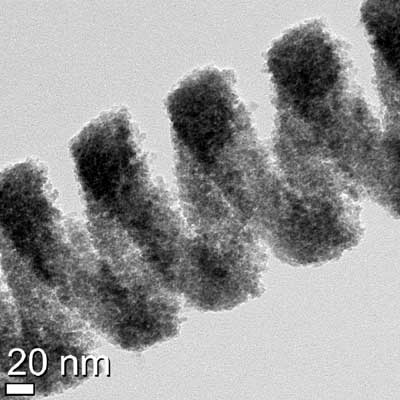| Nov 13, 2018 | |
Anticancer drugs to be delivered directly to cells by magnetic nanospring capsules(Nanowerk News) A team of scientists from the Far Eastern Federal University (FEFU) and Korea University (Republic of Korea) obtained cobalt and cobalt-iron nanosprings with unique combined magnetic properties and long-lasting elasticity that may be used to develop nanorobots, nanosensors, new types of memory, and targeted drug delivery agents (specifically, for anticancer therapy). The article was published in Nanoscale ("Magnetization reversal of ferromagnetic nanosprings affected by helical shape"). |
|
| Nanosprings are unusual objects that were discovered several years ago. Their magnetic properties have not been studied before, partially because it is difficult to obtain the structures of such a small scale. The nanospring wire is around 50 nm in diameter, which corresponds to a chain of only 200 atoms. | |
 |
|
| This is a microscope image of the nano-spring with diameter 20 nanometers. (Image: FEFU) | |
| "In the course of our experiments we obtained cobalt and cobal-iron nanosprings and studied their magnetic properties in detail for the first time," says Alexander Samardak, Associate professor of the Department of Computer Systems, School of Natural Sciences, FEFU. | |
| "Apparently, these chiral nano-objects show different magnetisation reversal processes comparing to cylinder-shaped nanowires under the action of an external magnetic fields. This property may be used for their efficient control including magnetic field-driven movement." | |
| According to the scientists, the mechanical properties of nanosprings are practically identical to those of macro-springs, which opens a range of possibilities for their use in nanotechnologies. | |
| "Nanosprings are unique objects with peculiar physical properties. This provides for their possible use in new data storage devices, nanoelectromechanical systems, and in biomedicine. Materials like this can be used to create nanomotors, protein molecules express testing systems, transportation capsules for molecular compounds, and many other useful devices," comments Alexey Ognev, Head of the Laboratory of Film Technologies at the Department of Physics of Low-Dimensional Structures, School of Natural Sciences, FEFU. | |
| The work was carried out within the framework of the 'Materials' priority science project implemented by FEFU. The team worked on the basis of the Laboratory of Film Technologies in collaboration with the Prof. Young Keun Kim's group from Korea University, as well as young scientists from the School of Natural Sciences, FEFU - postgraduate student Aleksei Samardak and Associate professor Alexander Davydenko. | |
| The 'Materials' priority science project of the Far Eastern Federal University unites gifted young physicists, chemists, biologists, and specialists in material studies. They have already developed a new type of optical ceramics for ground and space optical connection, a heat-resisting material with record-setting melting temperature, and a number of other prospective projects. |
| Source: Far Eastern Federal University | |
|
Subscribe to a free copy of one of our daily Nanowerk Newsletter Email Digests with a compilation of all of the day's news. |
